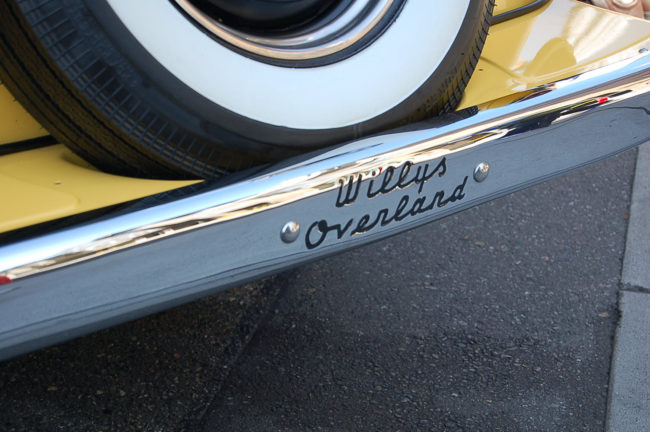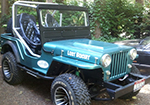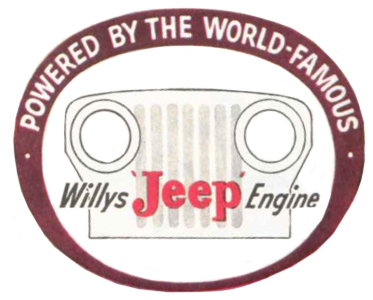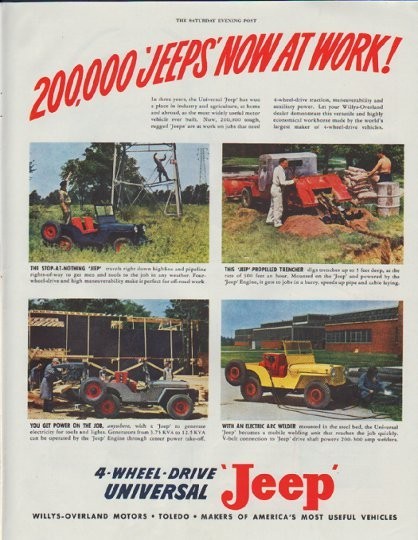Maury suggested we organize and go through the various Willys-Overland and Willys Motors logos, badges and slogans seen in brochures and ads during the years between 1941-1963. I thought that a good idea as well, so here’s what we found for the pre-Kaiser period between 1941-1953.
Before we begin, when is a slogan ‘a slogan’ and when not? It is totally arbitrary on our part, but we think we’ve covered quite a few (and welcome other suggestions). Much of Part I is a synopsis of advertising-related posts published over the last year. We hope to publish part II in the next few days.
1941-1945: (A deeper dive into the ads of this time period can be found here).
As a 1951 advertising review noted, the challenge facing Willys-Overland, once winning the jeep contract, was to convince consumers that the jeep was a Willys product (even though, as Ford argued, it was a joint project). To this end. Willys-Overland’s very first ad in December of 1941 emphasized WILLYS.

See the full ad here: http://www.ewillys.com/wp-content/uploads/2007/04/1941-12-13-sat-evening-post-jeep-in-civvies-650px-pg117.jpg
Willys-Overland continued this theme with their famous war-time color ads, a list of which you can view here (1942-1946). In the Hell Bent ad, the first of the war-time ads, Willys-Overland continued to emphasize WILLYS. The company also added “JEEPS” as a third category of vehicles for the first time.
In 1943, while emphasizing WILLYS, the company introduced a new badge, “The Sun Never Sets on the Fighting Jeep”

This ad, AVENGING JEEPS BLAST JAPS FROM CHINESE VILLAGE, was published in the February 06, 1943, issue of the Saturday Evening Post, page 85.
The “Fighting Jeep” phrase lasted through May of 1943. Then, was left off of a few ads, before returning on July of 1943 with the replacement of Fighting with Mighty: THE SUN NEVER SETS ON THE MIGHTY JEEP.

This ad, HEROIC OFFICERS DARE DEATH FOR MEN, was published in the July 17, 1943, issue of the Saturday Evening Post, page 97.
Willys-Overland continued to emphasize WILLYS until February of 1944, when the company abruptly switched the emphasis to JEEPS.
This strategy only lasted two months, most likely the short life can be attributed to the lawsuit over the trademark JEEP by Ford. So, Willys-Overland switch to a new phrase, WILLYS Builds the Mighty JEEP.
By the autumn of 1944, with the Allies making important advances in Europe, Willys-Overland tried a new ad tactic that literally linked Willys and Jeep together, as seen in an October 14, 1944, ad (and subsequently in the 1944 Annual Report for Willys-Overland).
This graphic was short-lived, disappearing by the end of 1944 in favor of WILLYS Builds the Mighty JEEP again until war’s end.
The Willys-Overland “J” Period 1945-early 1946 (deeper dive here):
Introducing the Jeep and educating consumers on its capabilities had its challenges. Apart from that, Willys-Overland faced challenges introducing the jeep, arguably an entire new model of vehicle, into the existing truck and car lines sold by Willys-Overland dealers. Additionally, dealers who sold jeeps faced additional costs, such as signage, yet one could imagine that dealers didn’t want to abandon the signage they already had displayed, as their customers identified with it, nor pay for all new signage
It’s for those reasons that we believe Willys-Overland introduced a new ‘badge’ that allowed existing signage to have a red JEEP added to it or dropped underneath it. This design introduced the serif “J” in jeep that would be subsequently be used in various forms throughout the 1950s and into the 1960s. Here’s an example of the badge that appeared on the late 1945 CJ-2A ads:
We believe the Florida dealership below demonstrates how the “J” may have been added to it (we have to direct evidence, just a guess). A “J” sign appears to have been added to the bottom of the hanging WILLYS sign (see the right side of the pic). Also, “J“s were added to the sides of the building (see the left hand side of the pic).
Willys-Overland Experiments with Logos and Slogans 1945-1949:
The end of the “J” badge in Willys-Overland advertisements at the beginning of 1946 was immediately followed by the “Get a ‘Jeep’” slogan, likely a play off of the popular “Get a Horse” slogan of the time (learn more about Get a ‘Jeep’). The “Get a ‘Jeep’” slogan can bee seen from early 1946 through November 1947. The slogan was only used with CJ-2As and never appears (based on the ads we’ve found) with the wagon.
Summer of 1946 — Station Wagon Introduction:
Instead of using the Get-a-‘Jeep’ slogan, Willys-Overland introduced the wagon as a ‘Jeep’ Station Wagon (and, subsequently with the introduction of trucks, the ‘Jeep’ Truck).

August 1946 Saturday Evening Post ad introduction the Jeep Station Wagon.
With the wagon ads, and hoping to continue to brand the Willys-Engine, Willys-Overland briefly pushed a new logo with the wagon ads, “Powered By the World-Famous Willys ‘Jeep’ Engine” badge. The logo only appeared in a few ads, then disappeared.
1947 — The “Universal” Jeep and Makers of America’s Most Useful Vehicles:
When Willys-Overland’s Get a ‘Jeep’ campaign ended at the end of 1946, part of the reason may have been that the company found itself with with two different jeeps, the 1/4 ton and the wagon. So, for advertising purposes, the wagon became the ‘Jeep’ Station Wagon and the 1/4 ton became the The Universal ‘Jeep’ (the term was not new, but this was the first use of it for marketing purposes on a regular basis). In terms of the Saturday Evening Post ads, this may have been first apparent in the May 10, 1947, ad Work-Horse of the World — the ‘JEEP’.
One other new addition to the advertising campaign was the new slogan at the bottom, MAKERS OF AMERICA’S MOST USEFUL VEHICLES. This phrase would endure for years, until its shift to The Worlds Largest Maker of 4WD Vehicles (ed note … still determining when this final shift occurred …. that said, the latter phrase does appear in two 1951 advertising pieces: see bottom of this post, so 1951 may be the pivot point).
1948 — City to City Wagon Campaign:
In 1948, Willys-Overland introduced a year-long city-to-city wagon campaign that included three specific attributes, though not placed next to one another. One was the brand ‘Jeep’, which was included in a red font. Two, the term Station Wagon was added in a semi-script black. Three, the W-over-the-O image in red and yellow (or gold?) was always somewhere on the ad. Here’s an example:

See all the city-to-city ads here . These ads also included the MAKERS OF AMERICA’S MOST USEFUL VEHICLES slogan
1947 — ‘Jeep’ Trucks:
In July of 1947, Willys-Overland introduced the ‘Jeep’ Truck. However, for advertising purposes, the company used the plural form of ‘Jeep’ Trucks often through roughly 1951. Yet, the Universal ‘Jeep’ and the ‘Jeep’ Station Wagon were always singular. Why do that? I haven’t a clue. Here’s an excerpt from the introductory ad published in the Saturday Evening Post:
In this example from 1949, a Lewiston, Washington, newspaper shows the entire line of jeeps, but only the trucks are pluralized:
4-Wheel Drive as a prominent Slogan:
In August of 1947, an ad that promoted 4-Wheel drive appeared in Time Magazine. It included an italicized “4-Wheel-Drive”, but not in the arrangement or form that would become standard later.
About that same time, Willys-Overland began stamping 4 Wheel Drive on CJ-2A tailgates (This stamp would appear through 1955). You can view an excellent review of this stenciling on the CJ-3B Page.

From this page: https://cj3b.info/Dating/4WDStencil.html
By mid 1948, 4-Wheel-Drive was appearing more regularly in niche magazine ads.
In November of 1948, Willys-Overland tested the phrase 4-Wheel-Drive Universal, all in blue, next to a red ‘Jeep’, but that combo of fonts and colors didn’t last long.
In September of 1949, Willys-Overland published a 4-Wheel Drive (no dash between Wheel and Drive).
Over the next few years, Willys (then Kaiser Willys) would alternate between 4-Wheel-Drive and 4-Wheel Drive, sometimes in the same brochure. View this partial 1953 brochure (with a Kaiser reference) which includes at least three versions of both types:

=========================
NOTE: As the 1950s arrives, Willys-Overland seems to prioritize the advertising of the wagon in periodicals like Colliers and Saturday Evening Post; It just so happens those two are the easiest to research on a month-to-month basis. Meanwhile, publications like the Country Gentleman and other more niche-oriented periodicals have proven much more difficult to obtain ads with dates; therefore, there’s yet no timeline of images to show how advertising changed over the years in niche periodicals. Still, we do have a wide range of dated magazine and newspapers ads that have, thus far, confirmed many of the observations here-in.
=========================
Late 1949 ‘Jeep’s become Willys:
In July of 1949, Willys-Overland began to re-insert the Willys-Overland brand back into the ‘Jeep’ brand. Why? Unclear at this time. On July 16, 1949, Willys published an ad for the WILLYS-OVERLAND ‘Jeep’ Station Wagon. By October 15, 1949, the Overland portion was gone, whittled down to just WILLYS ‘Jeep’ Station Wagon. By December 10, 1949, Willys-Overland dropped the branding of ‘Jeep’ down to a small badge. Instead, the WILLYS brand in solid red letters makes an appearance.
Here’s the badge, which lasted only a few ads: 
Interesting enough, Willys-Overland also produced a badge that was added to some (all?) 1950 models. Here’s an example:
This transformation from ‘Jeep’ to WILLYS branding can be seen over the following timeline of Saturday Evening Post ads.

Learn more about the 1948-1949 period here: http://www.ewillys.com/2019/05/18/willys-overland-sat-evening-post-ads-1948-1949/
In January of 1950, Willys-Overland dropped ‘Jeep’ entirely from the station wagon name. Now, it was the WILLYS Station Wagon.

January 07, 1950 Willys -Overland ad in the Sat Evening Post, page 86. Note the use of the ‘Jeep’ badge and the return of WILLYS as the primary brand.
1950 – WILLYS Makes Sense Campaign:
With the ‘Jeep’ Station Wagon repositioned as a WILLYS, Willys-Overland dropped the ‘Jeep’ badge and the ‘Jeep’ branding of the wagon as a ‘Jeep’. Instead, the company went full WILLYS branding and pursued a campaign called Willys Makes Sense (see all the Makes Sense ads), as seen in the September ad below. This seems incredibly strange, given the company had finally won the Trademark for JEEP that year (June 13, 1950 Awarded JEEP registered trademark).

September 23, 1950, Willys-Overland ad in the Sat evening Post, page 57. Note that ‘Jeep’ has disappeared completely from the advertising.
Additionally, thanks to Colin, we know that Willys even dropped the ‘Overland’ from the bumpers. Prior to 1950, rear bumpers on the Wagons and Jeepster had a scripted ‘Willys Overland’ pressed into the bumper. In 1950, that changed to just ‘Willys’. So, the shift in marketing from Willys-Overland to Willys appears to represent a company-wide push.


World’s Largest Makers of 4-Wheel Drive Vehicles:
The latest ‘new’ slogan that we could find prior to the Kaiser purchase of Willys-Overland was the phrase “World’s Largest Makers of 4-Wheel Drive Vehicles”, which appears on a 1951 brochure for the CJ-3A. As far as I can tell, it’s the earliest example of that phrase appearing in an ad. http://www.ewillys.com/2018/09/05/1951-jeep-will-do-more-jobs-brochure-on-ebay/ Here’s one page from that ad:
The same phrase appears at the bottom of a 1951 ‘Jeep’ Tractor ad, too:
We can only surmise that with Willys-Overland struggling over 1951 and 1952, that advertising became less of a priority. The ads in the major weekly magazines became less frequent. While there was a big push for the Hurricane engine (Hurricane Powered, Willys Puts the ‘F’ in Farm Power, etc,) that was a product push rather than a slogan.
That’s all we have for Part I, 1941-1953, of the Willys-Overland advertising branding and slogan discussion. We stopped Part I at this point because, after Kaiser completed their purchase (Kaiser Manufacturing Corp offered to purchase Willys-Overland Motors in March of 1953), Kaiser began investing in the advertising and re-emphasizing the ‘Jeep’ brand. In the next few days, we hope to publish something similar for the years 1953-1963.





















Whoa. This is awesome. Great post.
For the 1950 models of the station wagon, panel delivery and Jeepster, the script on the rear bumper read Willys where from 1946 through the early 1950 models, the script read Willys Overland, with the words being stacked, Willys over the word Overland. Tailgates on the station wagon had the wording Willys Overland in the top relief portion of the tailgate. Station wagons and trucks prior to 1950 had the inside step plates embossed with the written script Willys Overland. From 1950, that changed to just Willys. Terminology for Willys became Willys Motors, Inc. in 1951.
Jeep vehicles that were exported to other countries were handled through the Willys Overland Export Corporation through the end of 1964, and during the exporting of the DJ3A Galas and Surreys. Domestic sales were handled through Willys Motors, Inc. through the Kaiser era until the logo for the Kaiser Jeep Corportation made its debut.
Great research Dave!
Thanks for the added info Colin. I’ll add it, with examples, to the post.
– Dave
Pingback: Homepage
Question…when did Willys/Kaiser adopt the red/gold logo?
I found a nice key chain with that logo on Amazon and use it for my M38A1 key, so I suppose it is fairly correct for its 1955 year.
Hi John,
Do you mean this logo: https://www.ebay.com/itm/404955056433 ? I am pretty sure that was 1966.
Here’s what one person wrote: “The 62 – 73 book shows both the Blue/red and the Gold/red logos available for both the f4 and V6, but it was generally known that the Gold/red went with the V6 and the Blue/red on the f4, neither of which were offered after 1971.” from this page http://www.earlycj5.com/xf_cj5/index.php?threads/103802/
– Dave
Dave
Thanks.
Yes, that first link shows the logo I’m referring to.
So, ’66…I thought they were a few years earlier.
And like the guys on the forum referenced in your link, I’ve always equated the red and blue cross design to the early AMC years.
For a small outfit like Willys, (who seemed to like to keep things simple..i.e. “cheap”), I’d be surprised if they had two sets of wheel cover colors at the same time differentiating the engines. I’m not saying the color/engine theory is wring, just surprising.
Here is a copy of my post from 2013 on the Early CJ5 forum. After rereading it, I’m still confident of the post:
“Dog Dish were available through the dealerships for the 15″ rims starting around 1963 with the advent of the J-series. You could obtain them for CJs also. My 62-73 parts book shows them along with the full hub caps. The 62 – 73 book shows both the Blue/red and the Gold/red logos available for both the f4 and V6, but it was generally known that the Gold/red went with the V6 and the Blue/red on the f4, neither of which were offered after 1971. They were usually found on the Tuxedo Park and a good example is if you can find the movie of Elvis and girlfriend driving around in his and her CJ5 Tuxes, one in a blue and one in a red. If you wanted full hub caps, you could order the spoke beauty rings to go with the dog dish which was troublesome as the beauty rings required 5 mounting clips each. When I purchased my 73 CJ5 new from Thorpe’s Jeep in Sacramento, you could only get the full hub cap, also shown in the -73 book as part # 999878. All of the above required a cap without the center trademark for the front if you had manual hubs. WARNING to those shopping these: there were 2 sizes of them in both color options. The smaller, which is only about an 1/8″ difference, will not snap onto the rim requiring the larger one. As both offered front with lockout holes, the difference cannot be attributed to the smaller being dedicated to DJs with 4-lub wheels. More likely, it is agreed that this was due to different vendors of wheels for particular production runs or year models. Yes, I have some. I hope this helps or at least contributes to other posts on this subject. I posted this on another thread before seeing this main one, so I’m sorry for the duplication. Also, the gold/red ones were introduced in 1963 for the J-Series and are pictured with and without beauty rings in my Willys Motors introduction for dealers book dated 9/62.”
Barney, I didn’t realize that it was you I had quoted! I was in a hurry when I found that post. Great info!
No problem. I didn’t realize you were quoting me. lol. I was just amazed that my “research” had been around 11 years and I remembered where to find it.